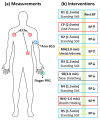BCG Signal Quality Assessment Based on Time-Series Imaging Methods
- PMID: 38067755
- PMCID: PMC10708708
- DOI: 10.3390/s23239382
BCG Signal Quality Assessment Based on Time-Series Imaging Methods
Abstract
This paper describes a signal quality classification method for arm ballistocardiogram (BCG), which has the potential for non-invasive and continuous blood pressure measurement. An advantage of the BCG signal for wearable devices is that it can easily be measured using accelerometers. However, the BCG signal is also susceptible to noise caused by motion artifacts. This distortion leads to errors in blood pressure estimation, thereby lowering the performance of blood pressure measurement based on BCG. In this study, to prevent such performance degradation, a binary classification model was created to distinguish between high-quality versus low-quality BCG signals. To estimate the most accurate model, four time-series imaging methods (recurrence plot, the Gramain angular summation field, the Gramain angular difference field, and the Markov transition field) were studied to convert the temporal BCG signal associated with each heartbeat into a 448 × 448 pixel image, and the image was classified using CNN models such as ResNet, SqueezeNet, DenseNet, and LeNet. A total of 9626 BCG beats were used for training, validation, and testing. The experimental results showed that the ResNet and SqueezeNet models with the Gramain angular difference field method achieved a binary classification accuracy of up to 87.5%.
Keywords: ballistocardiogram; classification; convolutional neural network; signal quality assessment; time-series imaging.
Conflict of interest statement
The authors declare no conflict of interest.
Figures






Similar articles
-
Novel methods for estimating the ballistocardiogram signal using a simultaneously acquired electrocardiogram.Annu Int Conf IEEE Eng Med Biol Soc. 2009;2009:5344-47. doi: 10.1109/IEMBS.2009.5333709. Annu Int Conf IEEE Eng Med Biol Soc. 2009. PMID: 19964385
-
ResNet-BiLSTM: A Multiscale Deep Learning Model for Heartbeat Detection Using Ballistocardiogram Signals.J Healthc Eng. 2022 Jan 27;2022:6388445. doi: 10.1155/2022/6388445. eCollection 2022. J Healthc Eng. 2022. Retraction in: J Healthc Eng. 2023 Nov 29;2023:9809587. doi: 10.1155/2023/9809587. PMID: 35126936 Free PMC article. Retracted.
-
Automatic detection of motion artifacts in the ballistocardiogram measured on a modified bathroom scale.Med Biol Eng Comput. 2011 Feb;49(2):213-20. doi: 10.1007/s11517-010-0722-y. Epub 2010 Dec 9. Med Biol Eng Comput. 2011. PMID: 21153058
-
Wearable ballistocardiogram and seismocardiogram systems for health and performance.J Appl Physiol (1985). 2018 Feb 1;124(2):452-461. doi: 10.1152/japplphysiol.00298.2017. Epub 2017 Aug 10. J Appl Physiol (1985). 2018. PMID: 28798198 Free PMC article. Review.
-
Ballistocardiogram signal processing: a review.Health Inf Sci Syst. 2019 May 16;7(1):10. doi: 10.1007/s13755-019-0071-7. eCollection 2019 Dec. Health Inf Sci Syst. 2019. PMID: 31114676 Free PMC article. Review.
References
MeSH terms
Grants and funding
LinkOut - more resources
Full Text Sources

